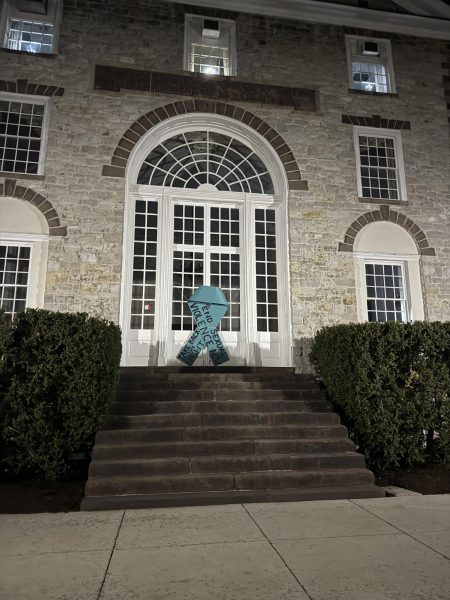13th Annual Potter Lecture Features Fish Fossils
A full house of Dickinsonians came together on Tuesday to hear Ted Daeschler spin prose on the history of fish fossils.
The lecture, “To the Ends of the Earth: Fossil Discoveries from the Age of Fishes in Pennsylvania and Beyond,” was the 13th annual Potter Lecture.
The lecture was a summary of Drexel University professor Ted Daeschler’s work, which included looking for fossils in Pennsylvania. Daeschler also talked about his most recent research in which he had the opportunity to look for fossils in Antarctica.
Daeschler teaches at Drexel University as an associate professor Department of Biodiversity, Earth & Environmental Science. He also has been involved in multiple research efforts with a common focus on fossils, particularly fossils from the Devonian time period. The time frame that Daeschler focuses on most is from about 365 million years ago, until 390 million years ago.
According to Daeschler, life developed in the water long before there was any life on earth, which is one of the reasons that Daeschler spends so much time studying deposits from “fresh water spring systems,” as he describes it.
The Devonian Age is dubbed as the “Age of Fish.” As Daeschler explained, the Devonian Age as “the end of arc forms [of species] and the beginning of something new.” This “something new” refers to the first species that had arms and legs, the first tetrapods. Although these animals did not evolve to have arms to leave the water systems, many scientists believe that the arms were used to aid the animals as they move around the dense ground of the streams, the appendages were instrumental in the movement of these species to land. These animals are of the utmost importance to life on Earth, as they were the first predecessor of many life forms found on Earth today.
The state of Pennsylvania is a hotspot for fossils from the Devonian Era. Daeschler praised one spot in particular, stating “This sight up in Clinton County is one of the best places to reconstruct the Devonian, period” he said. Road cuts are the best place to find fossils in the state rocks in these areas, as they have already been cut into and the different layers of rocks then become quite clear.
By pulling out an old college textbook and examining the rock patterns, Daeschler was able to find an area in Northern Canada, the Nunavut territory, that has very similar rock patterns to the rocks in Pennsylvania. Daeschler helped lead an exploration to this Canadian land in hopes of finding more Devonian fish fossils. The trip was extremely successful. As Daschler put it, there is “nothing better than wrapping up a cool fauna you know you are going to do some good science on.” And they found lots of fauna and fossils.
One head of a Tiktaalik, also known as a Fishapod, was almost fully intact. This is exciting for Daeschler as he, and many others, use these fossils as a means for better education on the transition of life to land.
More recently, Daeschler went on another trip after fish fossils, this time to Antarctica. The trip concluded in January of this year. Around 400 pounds of fossils will soon be arriving in California for Daeschler to organize and study.
The Potter lecture was made possible thanks to the help of alumni and friends of the Earth Science Department at Dickinson College. Professor Noel Potter, Emeritus Professor of Geology, organized the first of these talks over a decade ago. Potter has done research similar to Daeschler’s, in fact, they pitched camp in Antarctica in almost identical places.
The event took place in Denny 317 on Monday, February 27.





